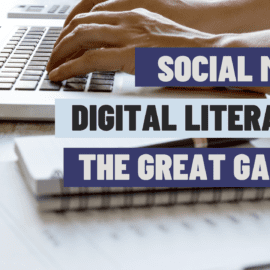If you’ve been teaching more than fifteen minutes, you’ve heard this advice about student engagement. And sure, connecting content to students’ experiences can be valuable. That’s why teachers everywhere are desperately:
- Searching TikTok for trending sounds to reference
- Following teen influencers to stay “current”
- Learning about whatever game is popular this week
- Trying to “speak their language” authentically
- Racing to keep up with youth culture
But here’s what I’ve noticed after 17 years in the classroom: The most engaged discussions often happen when I share connections I’m genuinely excited about – even if they’re not necessarily “relevant” to teens.

Table of Contents
Two Approaches to Student Engagement
Picture this: I’m teaching Macbeth. I have two options:
Student Engagement Option 1: Force “Relevant” Connections
- Compare Lady Macbeth to current teen drama
- Find social media parallels for every scene
- Make strained connections to high school politics
- Try to find trending references for every moment
Student Engagement Option 2: Share Real Analysis
- Break down how the play mirrors reality TV power dynamics
- Analyze character arcs like season-long story development
- Examine how ambition plays out in competition shows
- Draw on patterns I actually study in my own viewing
Guess which creates better student engagement and deeper discussion?
It’s not because reality TV is more “relevant” to students than their own experiences. It’s because:
- I bring genuine analytical insight from my deep understanding
- Students see authentic intellectual curiosity in action
- The connections emerge from real pattern recognition
- The analysis has actual depth and substance
- The thinking creates authentic discovery
Beyond Forced Relevance
Here’s what I’ve learned about real student engagement:
- Authentic interest is contagious – students respond to genuine enthusiasm
- Deep analysis builds natural connections across contexts
- Real patterns create genuine insights and discoveries
- Systematic thinking reveals meaning students actually care about
- True engagement comes from authentic intellectual work
Engineering Better Analysis
Instead of asking “How do I make this relevant?” try:
- What patterns do I genuinely see in this text?
- Where does my expertise offer unique insight?
- How does this connect to what I understand deeply?
- What makes this analysis actually matter?
- How can I model real analytical thinking?
From Surface to Substance
Real student engagement doesn’t come from:
- Forcing youth culture connections
- Pretending to share their interests
- Creating artificially “relevant” links
- Finding trendy references
- Racing to stay “current”
It comes from:
- Bringing authentic analytical thinking
- Sharing genuine pattern recognition
- Building real analytical tools
- Creating conditions for discovery
- Modeling intellectual curiosity
What Real Student Engagement Looks Like
Let me give you a specific example from my classroom. Recently, I was teaching The Great Gatsby. Instead of forcing connections to teen social media drama, I shared my fascination with how reality TV shows build and break alliances. Not that I don’t see the social media comparisons – I definitely do. It’s why I bring up the reality show The Circle and the parallels I see in that dynamic.
The discussion that followed was electric – not because students particularly cared about reality TV, but because:
- They saw genuine analytical thinking in action
- The patterns revealed something real about power and relationships
- The analysis had actual depth and complexity
- The connection emerged naturally from authentic interest
- They got to see (and appreciate?) my enthusiasm for the analysis
I also think we can learn a lot by studying the media that our students consume, but I don’t think it needs to be so…on the nose. The key wasn’t the specific connection – it was the quality of thinking it inspired. Students started noticing their own patterns, drawing on their own areas of expertise, building genuine analytical skills.
If the students make that connection to teen social media drama…great! That is their connection and we don’t need to make it for them.
Where Do We Go From Here?
We’re not ignoring student interests. When authentic connections to their experiences emerge, absolutely explore them.
But if you find yourself desperately searching for ways to “make it relevant,” try sharing what genuinely interests you instead. Your authentic analytical thinking will create better student engagement than forced connections ever could.
Want to build more engaging analysis in your classroom? Start with my free Discussion Engineering Mini-Course. You’ll learn:
- How to build real expertise (vs surface preparation)
- Why genuine knowledge gaps create engagement
- Ways to make everyone’s contribution matter
- How to design discussions that actually work
Because ultimately, student engagement isn’t about relevance – it’s about creating conditions for real thinking to flourish.
[Click here to access your free Discussion Engineering Mini-Course]
Teaching gets better when we bring our whole selves to it, including our genuine intellectual curiosity.



